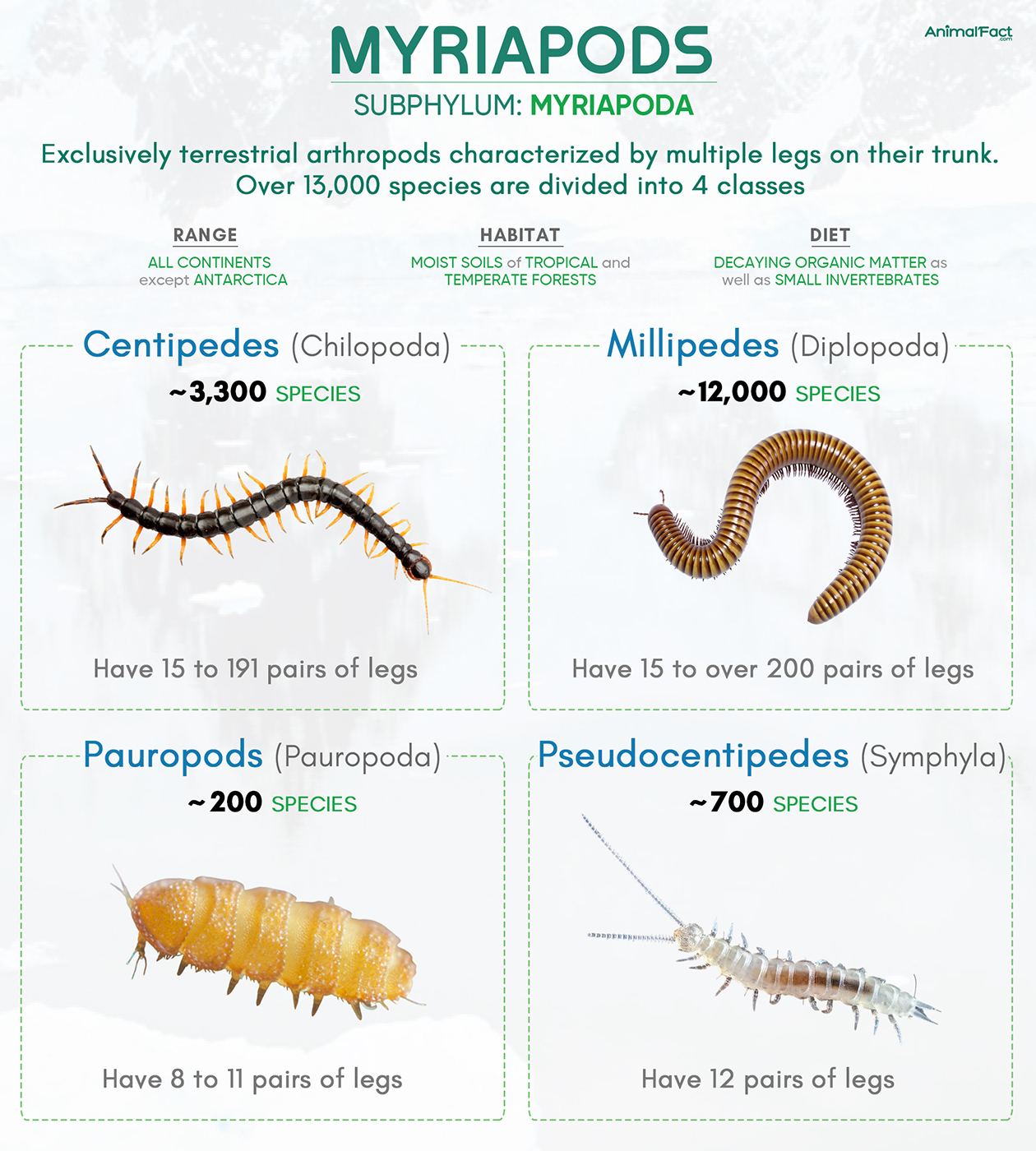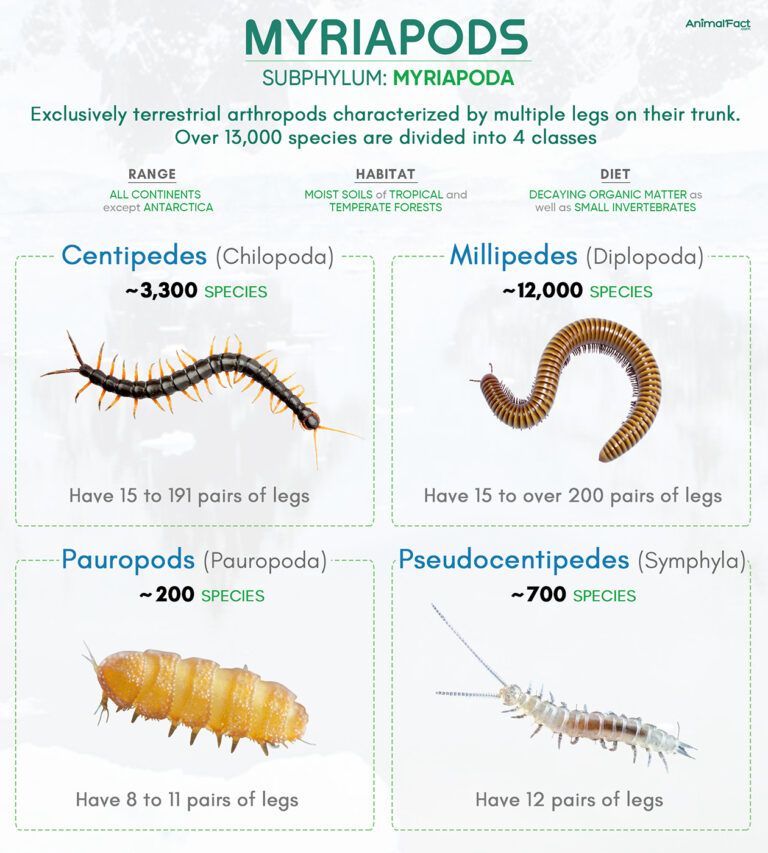


Myriapods are exclusively terrestrial arthropods that belong to the subphylum Myriapoda. They are characterized by an elongated trunk, containing numerous legs. The trunk is segmented, having one or two pairs of legs per segment.

These arthropods are widely distributed globally, except in Antarctica. They prefer living in moist soils of tropical and temperate forests. Over 13,000 species of myriapods are divided into 4 classes: Chilopoda (centipedes), Diplopoda (millipedes), Pauropoda (pauropods), Symphyla (pseudocentipedes).
Millipedes, pauropods, and pseudocentipedes are primarily detritivores, feeding on dead and decaying organic matter, and thereby play an important ecological role in replenishing soil nutrients.
The size of myriapods varies with the class and species.
Centipedes can measure less than 0.5 in (12 mm) to over 12 in (30 cm) in length, depending on the species. Similarly, millipedes range from 0.06 in (2 mm) to 14 in (35 cm).
Pseudocentipedes measure 1.1 to 2.3 in (3 to 6 cm), while pauropods are even smaller, typically 0.01 to 0.07 in (0.5 to 2.0 mm) long.
The body of a myriapod is divided into two broad sections: the head and the trunk.
The head bears a single pair of antennae, followed by simple eyes in most species. However, members of the millipede order Polydesmida and the centipede order Geophilomorpha lack eyes altogether. Centipedes in the order Scutigera, particularly Scutigera coleoptrata, bear true compound eyes like insects, composed of multiple ommatidia[1].
The mouth lies on the underside of the head. The upper lip comprises the labrum and the epistome. The lower mouthparts include the first and second maxillae, which may be separate or fused.
The trunk is elongated and divided into multiple segments, typically ranging from 10 to over 300 body segments, depending on the class. These segments bear paired legs, either one pair or two pairs. For instance, centipedes have one pair of legs per segment. However, in millipedes, except for the first segment, which lacks legs, the following body segments are fused in pairs (diplosegments), resulting in the appearance of two pairs of legs per segment. In general, myriapods possess fewer than 10 to nearly 200 pairs of legs, depending on the species.
Myriapods derive their name from the Greek words muríos (countless) and poús (foot), which refer to the numerous legs they bear in the trunk segment.
Over 13,000 myriapod species are divided into 4 classes, though the phylogenetic relationship among these classes remains uncertain.
The oldest-known fossils of myriapods date back between the Late Silurian and Early Devonian. The myriapod Pneumodesmus newmani, discovered from the Lower Old Red Sandstone in Stonehaven, Scotland, is the oldest reported air-breathing terrestrial animal. Other fossil species from around the same time include Kampecaris obanensis and members of Archidesmus.
Scientists are yet to reach a consensus on which arthropod group is phylogenetically closest to myriapods. There are several hypotheses in this regard. For example, the Mandibulata hypothesis suggests that Myriapoda is a sister taxon of Pancrustacea, a group comprising insects and hexapods. On the other hand, the Atelocerata and Paradoxopoda hypotheses suggest that myriapods are the closest to hexapods and chelicerates, respectively.
A recent study revealed similarities in the characters of the eye and preoral region of myriapods and Euthycarcinoids (an extinct group of amphibious arthropods), suggesting a close phylogenetic relation between them[2].
These arthropods are found on all continents except Antarctica. They are the most diverse in moist soils of tropical and temperate forests, though several centipedes are also found in grasslands.
Although myriapods thrive best in moisture-rich environments, some species, like the giant desert centipede (Scolopendra heros), are found in arid and semi-arid regions[3]. A few species, such as Thalassisobates littoralis, are found along the seashore[4].
Most myriapods are detritivores and typically feed on dead and decaying organic matter. They may occasionally consume fungal hyphae[5].
Only centipedes actively prey on other invertebrates, such as insects, worms, and spiders.
Though generally harmless, many millipedes, like Floridobolus penneri, produce toxic chemicals, often containing benzoquinones[6], which can cause temporary blistering and discoloration of the skin in humans.
Myriapods are gonochoristic, with separate male and female sexes. The males indirectly transfer their sperm through small packets of sperm called spermatophores, which they deposit on a substrate. The females pick the spermatophores up with their genital openings, and the eggs in their bodies get fertilized internally.
The females lay eggs in the soil or leaf litter, which hatch into immature forms with fewer segments and legs. In most myriapods, new body segments are added progressively through successive molts, a process known as anamorphosis. However, members of the centipede orders Scolopendromorpha, Scutigeromorpha, and Lithobiomorpha undergo epimorphosis, in which all body segments are formed during embryonic development.
The juveniles repeatedly molt to become adults.